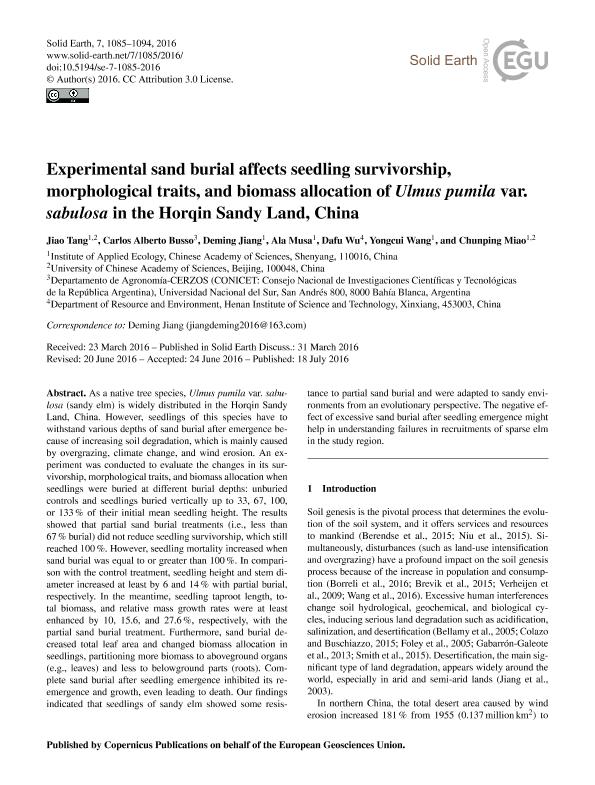Artículo
Experimental sand burial affects seedling survivorship, morphological traits, and biomass allocation of Ulmus pumila var. sabulosa in the Horqin Sandy Land, China
Tang, Jiao; Busso, Carlos Alberto ; Jiang, Deming; Musa, Ala; Wu, Dafu; Wang, Yongcui; Miao, Chunping
; Jiang, Deming; Musa, Ala; Wu, Dafu; Wang, Yongcui; Miao, Chunping
 ; Jiang, Deming; Musa, Ala; Wu, Dafu; Wang, Yongcui; Miao, Chunping
; Jiang, Deming; Musa, Ala; Wu, Dafu; Wang, Yongcui; Miao, Chunping
Fecha de publicación:
07/2016
Editorial:
Copernicus Publications
Revista:
Solid Earth
ISSN:
1869-9529
Idioma:
Inglés
Tipo de recurso:
Artículo publicado
Clasificación temática:
Resumen
As a native tree species, Ulmus pumila var. sabulosa (sandy elm) is widely distributed in Horqin Sandy Land, China. However, seedlings of this species have to withstand various depths of sand burial after emergence because of increasing soil degradation, which is mainly caused by overgrazing, climate change, and wind erosion. An experiment was conducted to evaluate the changes in its survivorship, morphological traits and biomass allocation when seedlings were buried at different burial depths: unburied controls and seedlings buried vertically up to 33, 67, 100 or 133% of their initial mean seedling height. The results showed that partial sand burial treatments (i.e., less than 67% burial) did not reduce seedling survivorship, which still reached 100%. However, seedling mortality increased when sand burial was equal to or greater than 100%. In comparison with the control treatment, seedling height and stem diameter increased at least by 6 and 14% with partial burial, respectively. In the meantime, seedling taproot length, total biomass, and relative mass growth rates were at least enhanced by 10%, 15.6%, and 27.6%, respectively, with the partial sand burial treatment. Furthermore, sand burial decreased total leaf area and changed biomass allocation in seedlings, partitioning more biomass to aboveground organs (e.g., leaves) and less to belowground parts (roots). Complete sand burial after seedling emergence inhibited its re-emergence and growth, even leading to death. Our findings indicated that seedlings of sandy elm showed some resistance to partial sand burial and were adapted to sandy environments from an evolutionary perspective. The negative effects of excessive sand burial after seedling emergence might help to understand failures in recruitments of sparse elm in the study region.
Archivos asociados
Licencia
Identificadores
Colecciones
Articulos(CERZOS)
Articulos de CENTRO REC.NAT.RENOVABLES DE ZONA SEMIARIDA(I)
Articulos de CENTRO REC.NAT.RENOVABLES DE ZONA SEMIARIDA(I)
Citación
Tang, Jiao; Busso, Carlos Alberto; Jiang, Deming; Musa, Ala; Wu, Dafu; et al.; Experimental sand burial affects seedling survivorship, morphological traits, and biomass allocation of Ulmus pumila var. sabulosa in the Horqin Sandy Land, China; Copernicus Publications; Solid Earth; 7; 4; 7-2016; 1085-1094
Compartir
Altmétricas



